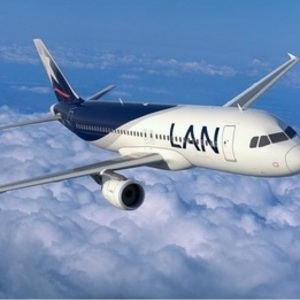Bogota to Cali flight on biojet fuel makes for a Colombian first

Photo: LATAM Airlines Group
August 28, 2013
BY LATAM Airlines Group
In the pursuit of having an even more sustainable operation, LAN Colombia, member of the LATAM Airlines Group, with the help of Terpel, recently marked a milestone in the country’s and region's commercial aviation history by carrying out the first flight in Colombia using second-generation biofuel. The aircraft used for the flight was an Airbus A320 between the Colombian cities of Bogota and Cali. The fuel was made from camelina, and it meets the strictest technical standards required to fly.
The flight took off from Bogota's El Dorado International Airport on Aug. 21 at 10:00 a.m. local time, carrying 174 passengers on route to the city of Cali, where an event was held to celebrate the milestone. LAN´s executives—among them Colombia's CEO, Hernán Pasman—and Terpel executives, were part of the celebration that welcomed local authorities and members of the press.
Ignacio Cueto, CEO of LAN Airlines, said, “This milestone represents our second initiative in this area. At LAN we aim to develop sustainable biofuels for commercial aircraft with a high production potential in South America. Without a doubt, this is another key step toward the future of the industry. These renewable energy sources play a significant role in global aviation and will increasingly impact decision-making in the industry and in our company.”
Advertisement
LAN pioneered this type of flight in South America when it flew between the cities of Santiago and Concepcion on March 7, 2012. With the help of Terpel, LAN now becomes the first to carry out this type of flight in Colombia—a country privileged when it comes to producing biofuels due to its favorable climate, availability of land for crops and geographic location. In addition, it has a regulatory framework that stimulates biofuel production and trade.
According to Sylvia Escovar, president of Terpel, the flight is “a major commitment that not only contributes to growing the aviation industry in the country and region, but also has a positive impact that invigorates the agricultural industry and provides a significant step for Colombia's export efforts.”
LAN Colombia chose the Bogota-Cali route because Cali is a strategic city for consolidating LAN's operations in the country. At the same time, the Cauca Valley led the way in Colombia's biofuel production, making it a symbolic department to start this type of project in the country.
Advertisement
By using second-generation biofuel for the flight, greenhouse gas emissions were reduced significantly since no additional carbon dioxide (CO2) was released into the atmosphere.
This type of fuel can be produced using any renewable biological carbon material. The most common sources are plants, which absorb CO2 and use sunlight to grow. Throughout the world, biofuels are used for transportation, heating, stationary engine power generation and cooking.
The biofuels used for this type of flight are known as second generation, since they can be obtained from plants such as algae, jatropha, and camelina, or from organic waste such as vegetable oils. They may be processed, burned directly, or put through a chemical process to become high-quality fuel. In the case of the Bogota-Cali-Bogota flight, the biofuel used came from a plant called camelina.
The biofuel used in aviation meets the highest technical standards required for flight. This mixture of up to 50 percent jet fuel has the same properties and meets all of the technical specifications of Jet A1, the fuel traditionally used in commercial flights. For this first flight in Colombia, a mixture of 33 percent biofuel and 67 percent Jet A1 was used.
By using biofuels for a biofuel flight, the CO2 released is almost the same as what was captured by vegetable crops during growth; therefore, there is no additional release of CO2 into the atmosphere.
Second-generation biofuels, such as the one used for this flight, are fuels derived from a raw material that does not compete with food sources or with basic human resources. They do not occupy areas that can be used to cultivate crops, which is essential in the development of this resource and of our planet.
Related Stories
Airbus is taking a significant step toward scaling the adoption of sustainable aviation fuel (SAF) by testing a new “Book and Claim” approach. This initiative aims to boost both supply and demand for SAF worldwide.
Signature Aviation, the world’s largest network of private aviation terminals, has announced the expansion of its blended SAF offering at six new locations across Europe following multiple blended SAF supply agreements.
Virgin Australia has entered an agreement with Viva Energy to SAF for its flights departing from Proserpine, Queensland. The SAF will consist of Jet A1 and a 30-40% synthetic blend component made from waste and residue feedstocks.
The largest single volume order of sustainable aviation fuel (SAF) by a DB Schenker customer has been placed by Mercedes-Benz. The order is for approximately 13,000 metric tons of SAF and is expected to reduce CO2 emissions by 40,000 metric tons.
ADM and Loyola University Chicago Searle Biodiesel Lab have joined the expanding B20 Club. Founded in 2014, the B20 Club is a partnership between the Illinois Soybean Association and American Lung Association.
Upcoming Events










